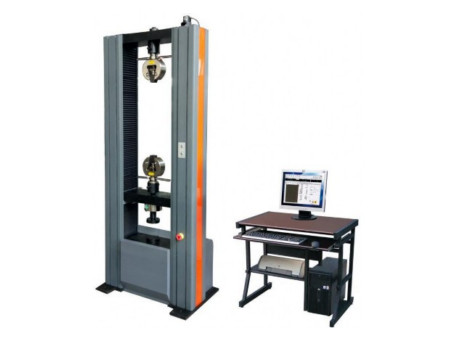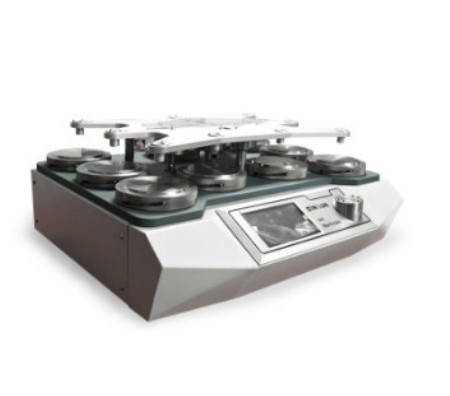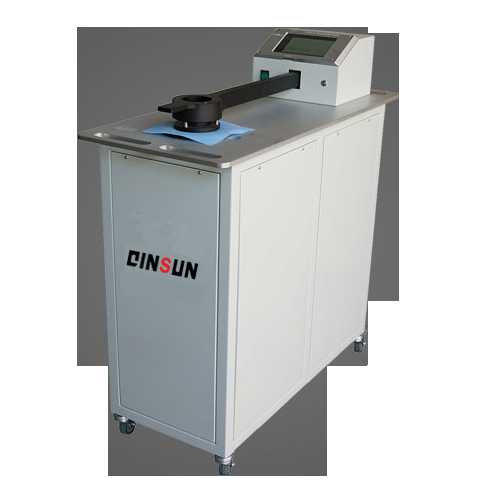Site: Home > Home > News and events
Fabric testing involves the evaluation of various properties and characteristics of fabrics to ensure their quality, performance, and compliance with industry standards. There are several machines and instruments commonly used in fabric testing, each designed for specific types of tests. Here are some of the key machines used in fabric testing:
1. Universal Testing Machine (UTM):
Universal Testing Machines, also known as tensile testing machines, are versatile instruments used for evaluating the physical properties of fabrics. They can measure parameters such as tensile strength, elongation, tear strength, bursting strength, and seam slippage. A UTM typically consists of a load cell, grips or clamps for sample fixation, and a motorized system for applying controlled tension or compression to the fabric.

2. Elmendorf Tear Tester:
The Elmendorf Tear Tester is specifically designed to measure the tear strength of fabrics. It determines the force required to tear a fabric specimen using a pendulum-type tearing mechanism. The instrument provides information about the resistance of the fabric to tearing in both the warp and weft directions.
3. Martindale Abrasion and Pilling Tester:
The Martindale Abrasion and Pilling Tester is used to assess the abrasion resistance and pilling tendency of fabrics. It consists of a circular test specimen holder that rubs against an abrasive surface or another fabric sample in a controlled manner. The number of cycles and the appearance of abrasion or pilling are evaluated to determine the fabric's durability.

4. Crockmeter (Color Fastness to Rubbing Tester):
Crockmeter is employed to determine the colorfastness of fabrics to rubbing or crocking. It assesses the tendency of the fabric's color to transfer or rub off onto other surfaces, such as skin or other fabrics. The instrument uses a controlled rubbing motion to evaluate the color transfer and assigns a rating based on the resulting staining.
The Air Permeability Tester measures the breathability or air permeability of fabrics. It determines the ease with which air can pass through the fabric, which is crucial for applications such as clothing, medical textiles, and filtration materials. The instrument utilizes a differential pressure method to measure the airflow through a known area of the fabric.

6. Moisture Management Tester:
Moisture Management Testers evaluate the ability of fabrics to transport and dissipate moisture or sweat. These instruments simulate real-world conditions to assess moisture absorption, wicking, spreading, and evaporation properties of fabrics. They can provide insights into the fabric's comfort and performance in activities such as sports and outdoor wear.
7. GSM Cutter and Balance:
The GSM (Grams per Square Meter) Cutter and Balance are used to determine the fabric's weight per unit area. A GSM cutter is employed to cut a specific-sized fabric sample, which is then weighed using a precision balance. Dividing the weight by the sample area provides the fabric's GSM value.
8. Ball Burst Tester:
The Ball Burst Tester measures the bursting strength of fabrics. It determines the force required to rupture a fabric specimen using a spherical-shaped plunger. This test assesses the fabric's resistance to bursting or breaking under pressure, which is essential for applications such as upholstery, protective clothing, and inflatable structures.
9. Flammability Tester:
Flammability Testers are used to assess the flammability and fire resistance properties of fabrics. These instruments apply a controlled ignition source to evaluate the fabric's reaction to flame, its ignition propensity, flame spread, and other fire-related characteristics. They help ensure the safety and compliance of fabrics used in various industries.
10. Light Fastness Tester:
Light Fastness Testers evaluate the colorfastness of fabrics when exposed to light. They simulate natural or accelerated sunlight conditions to assess the fabric's resistance to fading or color change caused by UV radiation. This test is crucial for fabrics used in outdoor applications or products exposed to sunlight.
11. Washing and Shrinkage Testers:
Washing and Shrinkage Testers simulate laundering conditions to evaluate the fabric's dimensional stability, colorfastness, and other performance aspects after repeated washing cycles. These machines typically consist of multiple washing compartments, temperature control, and mechanical agitation to mimic real-world washing conditions.
12. Crease Recovery Tester:
Crease Recovery Testers assess the fabric's ability to recover from creasing or wrinkling. They subject the fabric to controlled creasing or folding and then measure its ability to recover its original shape after a specific period. This test provides insights into the fabric's resilience and wrinkle resistance.
13. Yarn Count Testing Machine:
Yarn Count Testing Machines determine the linear density or thickness of yarns used in the fabric. They measure the yarn count, which indicates the fineness or coarseness of the yarn. These machines are essential for quality control and yarn classification purposes.
14. Electronic Color Matching Spectrophotometer:
Spectrophotometers are used to measure and analyze the color properties of fabrics. They can measure color values, color differences, and colorfastnessstandards. These machines and instruments play a crucial role in ensuring the quality, performance, and compliance of fabrics in various industries. However, it's important to note that the specific machines used in fabric testing may vary depending on the specific requirements, standards, and testing protocols followed by different organizations or laboratories.
Copyright 2022:Qinsun Instruments Co., Limited
High-end textile tester supplier Email:info@qinsun-lab.com | Textile Testing Equipment pdf | Tel:021-67800179 |